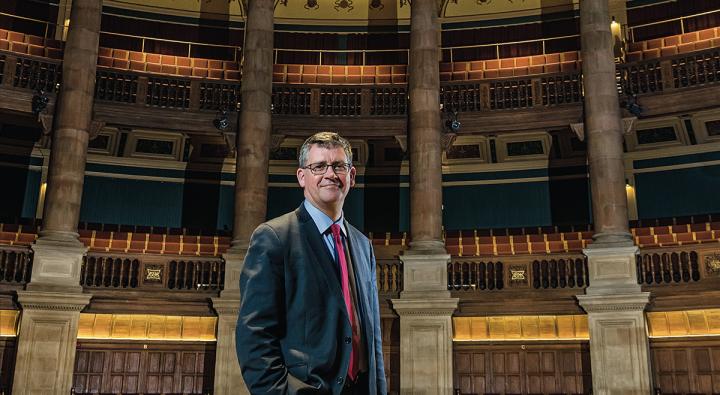Revitalising a symbol of civic pride
The University's magnificent McEwan Hall has been restored to its former glory.

When William McEwan donated £115,000 to the University in 1886, it was the largest single donation the University had ever received, and it sparked the creation of a magnificent landmark that would host public events and graduation ceremonies for generations to come.
Restoring a landmark
In 2015, the doors to the McEwan Hall were closed to restore the Grade A-listed building back to its original glory. The £35million refurbishment took place over two years, with the Hall reopening in summer 2017 to the great excitement of staff and students alike, and to the great pleasure of graduating alumni, their parents and friends.
As well as making critical structural improvements, the windows, stonework and frescos were conserved, and the building was updated to meet modern-day accessibility requirements. While the University made a significant contribution from its own funds, alumni and donors played an important role in this chapter of the building’s story.
For Mr Chris Cox, Vice-Principal Philanthropy and Advancement, the spirit in which the original donation was made, strikes a chord with generous donors today: “William McEwan was the MP for Edinburgh Central and had huge pride in the city and the University,” he says. “McEwan saw universities as places where people from all walks of life could convene. This is as important today as it was then. Swingeing funding cuts in the mid-19th century meant that to build this wonderful civic building, the University really needed the generous support of benefactors.”
Fortunately the University’s secure financial position today enabled it to contemplate this major renovation. However, without the generosity of University benefactors the completed upgrade may not have had the same impact.
McEwan saw universities as places where people from all walks of life could convene.
This is as important today as it was then.
Pathways to Enlightenment
A campaign entitled Pathways to Enlightenment was launched in early 2016. To honour the original benefaction, alumni were invited to make a gift of £115, and in return, their name was inscribed on a tile, used within the newly restored building.
The response to the campaign was unprecedented, with more than 1,700 alumni from more than 50 countries contributing to the redevelopment. For Mr Cox the participatory nature of the campaign was important: “It was about finding a way in which hundreds, and eventually thousands, of alumni could connect themselves to this historic building, which clearly means so much to so many people.”
Current students were also at the heart of the redevelopment. A competition was held for third-year art students to design the tiles that would recognise donors’ contributions. Inspired by images held in the University’s research collections digital archive, the winning undergraduates – Lizzie Bevington and Despina Petridou – proposed an innovative concept that represented people and ideas moving through the University.
The University’s Art Collections Curator, Mr Neil Lebeter was closely involved in the project and saw the commission of students’ work as being the ideal way for the University to support emerging artists.
“As well as thanking our donors in a thoughtful and unique way, commissioning young artists talks to the future, as well as referencing the history of the institution,” says Mr Lebeter. “Lizzie and Despina did an amazing job. To be involved in such a major project was fantastic work experience for them.”
Architectural Conservation students were also given the opportunity to work alongside specialist conservators at the highest reaches of the Hall; learning how to clean and renovate the original murals. Anushka Desouza was one of the students to take part: “Working on the building helped me to implement the techniques learnt in the classroom,” she says. “It definitely enhanced my experience of studying at Edinburgh. It was an opportunity that I wouldn’t have found anywhere else, and I feel like I’m a part of the fabric of this historic building.”
Preserving Edinburgh's skyline
McEwan Hall is one of many landmarks on Edinburgh’s skyline that the University has committed significant investment to restore, maintain and improve.
Work is to begin shortly on the Grade A-listed Old Royal Infirmary. The former city-centre hospital was purchased by the University in 2015, after it lay vacant for more than 12 years. Due to reopen in 2021, it will be home to the Edinburgh Futures Institute, creating new teaching, research and public spaces.
The Pleasance complex plays host to a great variety of student societies, as well as becoming a busy hub during the annual Festival Fringe. The University has worked closely with the Students’ Union to improve and extend facilities and maximise space over the past year.
St Cecilia’s Hall – Scotland’s oldest purpose-built concert venue – reopened in May 2017, after a £6.5 million redevelopment. The concert room and music museum situated in the Old Town is open to the public from Tuesday to Saturday, after previously opening at sporadic times, and the renovation has also brought about a lively programme of concerts and events for the local community to enjoy.
“Our musical instrument collection is highly renowned worldwide,” says Ms Jacky MacBeath, the University’s Head of Museums. “Now we have facilities that match the quality of our collection and expertise of our staff. And the response we’ve had from the local community since reopening has been wonderful.”
The University’s commitment to having a strong relationship with the people of Edinburgh through these visionary yet accessible refurbishment projects fills Mr Cox with optimism. He concludes: “It’s wonderful that the University is investing so much into developing this network of inspiring spaces – giving enormous benefits to our students and alumni – and the city of Edinburgh as a whole.”
Photo © Tricia Malley Ross Gillespie www.broaddaylightltd.co.uk

